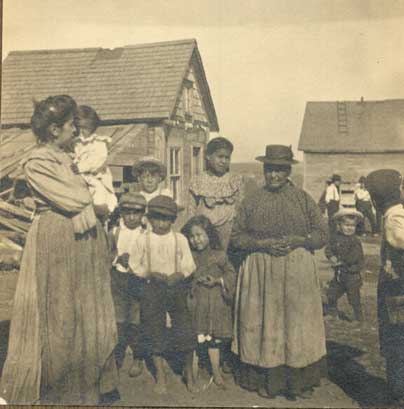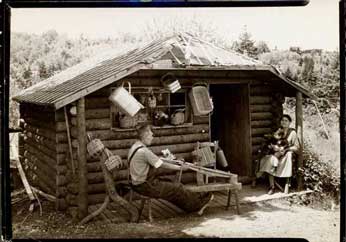"These
donations are due…to the efforts of the lady
members"
Aboriginal Women
Artists
In 1885, members of the New Brunswick Natural History Society
(NHS) learned that the Royal Society in Ottawa wished to augment its
collection of local Aboriginal utilitarian and cultural items. Around the
same time, NHS Secretary Samuel Kain supported this objective in New
Brunswick, reminding the provincial Society that its collection should
include more examples of modern Aboriginal implements. Writing to museum
colleagues in Nova Scotia, Kain discovered that they too held very few
Aboriginal artefacts and pottery samples. New Brunswick's NHS responded to
this dearth in a number of ways, beginning in earnest around the turn of the
century. One strategy was for Society leaders to accompany groups of senior
and junior members on regular collecting expeditions along New Brunswick's
rivers, where they unearthed axes, scrapers, stone weapons,
pottery, hammers and other tools, many of which became part of the Museum's
collection.
When William MacIntosh became Curator in
1907, he redirected the focus of collecting from midden-scavenged tools to
Aboriginal handiwork and craft items. To this end, he enlisted the
enthusiastic help of the Ladies' Auxiliary, whose members scoured their own
collections for Native-made artefacts. By the following year they had
presented the Museum with 5 quill and birchbark boxes, 18 specimens of
beadwork, and 11 baskets. Along with this solicitation came a lively series
of lectures, tableaux and activity sessions designed to acquaint audiences
with "Indians' manner of dress, their habits and customs, their use of home
made implements and their domestic affairs" as well as
"beautiful…legends"
and the "important part that Indians have played in the history of the
continent." The ladies of the NHS delivered these
lectures and led junior members in face-painting, fire-building,
meal-preparing and skin-stretching activities, all calculated to "show
the Indian's great love of nature and the spirit
with which he studied the signs of lake, forest and river."
|
 |
|
|
New Brunswick Museum, Saint John, N.B., X10724 (detail)
Moli Elizabet
Francis, Mrs. John Alexander, Noel Francis, MAKAW and Others at Neqotkuk
(Tobique First Nation), c. 1904
|
|
These romantic representations of
Aboriginal peoples tell us more about the social and cultural views of the
white, middle-class members of the NHS than about Native people themselves.
Archival records indicate that Aboriginals were not involved with these
presentations, and the early accession records of
the NHS Museum make only occasional references to the producers of the
Aboriginal objects that white collectors so fervently desired. It is clear
that most, if not all, of the baskets, quillwork boxes, beadwork items and
clothing were made by Aboriginal women living in the region. Often the
references are frustratingly vague. A written tally of gifts made in 1907,
for example, indicates that Mrs. Gilbert Murdoch donated a birchbark
box decorated with porcupine quills that was produced by "a Micmac Indian
woman" in Prince Edward Island. Yet other notations are more specific,
naming the female creators of valued objects. In 1908, Curator William MacIntosh noted that he had purchased five pieces of Indian basketwork
"made
by Mrs. Lolar and bought from Lolar, Chief of the Passamoquoddy Indians."
In 1910 and 1911, MacIntosh regularly approached
Passamoquoddy and Wolastoqew
women for baskets of their own
manufacture. In an effort to represent archaic Native handcrafts, he
commissioned a skilled basket maker,
Molly (or Mary) Sacobi, to
produce baskets from traditional patterns that were no longer in common use.
Sacobi provided several baskets "copied from an ancient type… no longer
made" and donated additional items to the Museum in the early 1900s.
|
|
 |
|
|
New Brunswick Museum, Saint John, N.B., X11678
Wolastoqew Family with
Baskets,
New Brunswick, c. 1935
(click to enlarge) |
Throughout the twentieth century, the Museum's collection has
been enriched through contributions from Aboriginal women eager to represent
their craft and cultural heritage with valuable samples of handiwork
– their
own or their predecessors'. These objects are important historical
documents, and cannot be classified as "objects simply produced for the
marketplace." According to art historian Ruth Phillips, souvenir trade wares
were "in many ways…the most authentic representations of the courageous,
innovative, and creative adaptation" that Aboriginal peoples made during the
period of their colonization. Objects produced by Aboriginal women continued
to be valued into the twentieth century; their avid collection and display
by the female members of the NHS provides only one example of the
complexities of cultural exchange at the time.

Sources
 |
Natural History Society fonds,
New Brunswick Museum Archives and Research Library. S127-9 (especially NHS
scrapbook, 1862-96, F120). |
 |
Phillips,
Ruth. Trading Identities: The Souvenir in Native North American Art
from the Northeast, 1700-1900. Seattle: University of Washington
Press, 1998. |
 |
Provincial Archives of New
Brunswick, Vital Statistics: Marriage Records. |
 |
New Brunswick Museum accession
database. |
 |
Saint John Globe, 1
November 1907. |
 |
Saint John Daily Telegraph,
15 October 1907. |
 |
Bulletins of the Natural
History Society,
XXVI (1908), XXIX (1911). |
|
|
From Their
Collections
~~~~ |
![]()